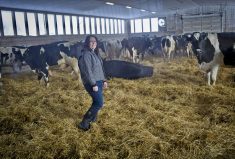Manitoba’s major checkoff-funded farm commodity groups are working with a consultant to explore increased collaboration aimed at giving farmers more bang for their levy bucks.
“We are excited to see what this may evolve into and we are just at the initial stage,” Reston farmer and Manitoba Wheat and Barley Growers Association (MWBGA) chair Fred Greig told the association’s annual meeting Feb. 11 during Crop Connect in Winnipeg.
The other groups involved are the Manitoba Corn Growers Association, Manitoba Canola Growers Association, the Manitoba Pulse and Soybean Association and National Sunflower Growers Association.
Read Also

Manitoba sclerotinia picture mixed for 2025
Variations in weather and crop development in this year’s Manitoba canola fields make blanket sclerotinia outlooks hard to pin down
“(H)ow long can we sustain the current model of multiple associations providing overlapping representation to the same membership?” Kyle Friesen, Altona farmer and outgoing chair of the Manitoba Pulse and Soybean Growers Association (MPSGA) wrote in the association’s annual report.
“I see a great opportunity to improve efficiency of grower levy funds through collaboration, communication and possibly consolidation.”
In a later interview, Greig didn’t rule out the possibility of following Ontario’s lead. Its barley, corn, oat, soybean, and wheat associations came together to form one organization called the Grain Farmers of Ontario.
“I don’t think producers require another level of bureaucracy, so if we can streamline more of the dollars to go to research and market development that would be good,” he said.
Merging could create economies by sharing an office and staff, Greig said. In addition to being more efficient, a bigger organization could attract more experienced staff, he added.
It’s not a new concept. In early 2013, Halbstadt-area farmer Danny Penner called on Canadian crop growers to form a national association so checkoff dollars for research, policy development and lobbying are used more efficiently and effectively.
“It may not happen from this initiative, but it will happen,” Penner predicted during an interview March 7, 2013. “It has to happen and if it doesn’t happen we’re going to be in trouble because we’re going to lose control of our own industry.”
Checkoff fatigue
Farmers were already complaining about checkoff fatigue, and that was before the MWBGA was created.
While Penner was proposing a single national organization, current talks involve only Manitoba commodity groups. However, Greig stressed the MWBGA is working hard to co-operate with its counterparts in Saskatchewan and Alberta.
Each commodity group promotes its crop to build revenue, but all the money comes from the same farmers who grow many crops. By coming together, one organization can take a more holistic approach.
“There’s a fear initially that smaller crops like barley are going to lose control, but I think if the organization is structured correctly, and if our checkoff on barley raises $700,000 then for the most part we try to spend $700,000 on barley,” Greig said.
The MWBGA is keen to work with other Manitoba commodity groups because, as a fledgling association, it has contracted its administration out. As well, the corn growers could soon lose their longtime senior executive, as Theresa Bergsma prepares to retire in a year.
“So it gets people thinking. I think all the groups are supportive and I think maybe pulse growers are the next closest to hoping this will evolve into something.”
Friesen told the MPSGA annual meeting Feb. 10, commodity groups need to co-operate to “reduce overlap” and get the most out of farmers’ money.
In a later interview, Friesen said he has no preconceived model.
“If there are groups with the same purpose, why not have one group instead of two? It reduces overhead and makes things more efficient,” he said. “I’m not going to be the guy saying this is how it has to get done.”
Worth it
Forming the Grain Growers of Ontario (GGO) in 2010 wasn’t easy. But it was worth it, its chief executive officer Barry Senft said in an interview in 2013.
“It wasn’t without some hiccups, to describe it kindly,” he said.
“I think the bottom line is the producers got to take hold of the process — the grassroots producers.”
While some initially feared their commodity wouldn’t be properly represented, he doesn’t think most would go back to the old system now.
“We went on the basis whatever a commodity needed, whether it was research or market development, that’s where the funds were going to be directed,” Senft said. “It has worked well.”
A merger of Manitoba’s grain commodity groups raises questions, including where it would be headquartered. The Manitoba Corn Growers Association owns an office in Carman and is home for the MPSGA and MWBGA. The Manitoba Canola Growers Association is based in Winnipeg.
How would the Keystone Agricultural Producers (KAP), Manitoba’s voluntary general farm organization be affected?
“We don’t see the merging of commodity groups as a threat,” said KAP president Dan Mazier.
“We have a role to play (in developing farm policy) and we all have interest in making the industry better.”
Under Manitoba legislation, farm commodity groups are obliged to focus on research and market development, not farm policy, which is KAP’s forte.
Creation of the Grain Growers of Ontario doesn’t appear to have hurt the Ontario Federation of Agriculture (OFA), which is equivalent to KAP. With 37,000 individual and 28 commodity group members, including the Grain Farmers of Ontario, the OFA describes itself as Canada’s largest voluntary general farm organization.




















